|
|
|
Comparison
between the sign-systems...
|
|
|
Comparison
between the sign-systems of the |
Briefly about the sign-system of the Carpathian Basin
1. The ancient Hungarian runic (rovás) script
The ancient Hungarian runic script developed in the Carpathian Basin. The oldest relics of this revealed until now are signs originating from a 15-20,000 year-old undisturbed layer on a stick in Jankovich cave in Bajót (North Hungary). The symbols on the Tatárlaka (Tartaria) Disc are 7,500-8,200 years old. There are further 6-7,000 year-old relics of this writing, found by Zsófia Torma archeologist (1831-1899) during her excavations near to Tordos, Transylvania. On the territory of the historical Hungary (see the maps made before 1920) several relics of runic writing have remained on stones, church walls, in books, on objects made of bone, wood, silver and gold.
The relics of the runic writing prove the origin of the Hungarian people in the Carpathian Basin (see Klára Friedrich: Tatárlaka titka (Mystery of Tatárlaka) at the website: www.magtudin.org).
The runic script is used even nowadays by the Hungarians; on the territory of the historical Hungary at least one hundred thousand people use it in their daily life. It is now the 10th year since Gábor Szakács journalist, researcher of the runic writing has been organizing competitions for the youth between 9-18 years of age, with an average participation of 700 competitors. So the 15-20,000 year-old symbols are absolutely suitable for use in our days as well, all the more because the sounds of the Hungarian language can be put down perfectly only by this type of writing. Here it is to be mentioned that in the 10th century, when the ancient writing of the Hungarians had to be replaced by Latin letters, 13 sounds of their language (TY, GY, NY, SZ, ZS, CS, LY, J, K, Á, É, Ö, Ü) were missing from the Latin alphabet.
2. Signs on the megalits on Tászok-tető
Tászok-tető can be found in the Carpathian Basin, in Transylvania. Descriptions say that on the 1013 m high plateau and in the surroundings there were several hundreds of written stones, with an average size of 180 x 140 cm. Two unharmed megalits are exhibited in the Tarisznyás Márton Museum in Gyergyószentmiklós, Transylvania and there are some broken stones still laying on the plateau, that's all today. Based upon the parallels it can be stated that the majority of the scripts is about 10,000 years old (see Klára Friedrich: Megalitok a Tászok-tetőn (Megalits on Tászok-tető) in the book: Klára Friedrich-Gábor Szakács: Tászok-tetőtől a bosnyák piramisokig (From Tászok-tető to the Bosnian pyramids) - 2007, available only in Hungarian.
3. Signs of the Tordos-Vinca culture
The excavator of the Tordos culture was the above mentioned archeologist, Zsófia Torma. From 1875 she found thousands of clay discs deriving from the neolithic period. Most of the signs on these discs equal to those of the ancient Hungarian runic script being in use even today. In Vinca, a settlement near to Nándorfehérvár (since 1920 Beograd, Serbia) and in the surroundings plenty of artifacts from the neolithic age were revealed from 1905 (see the map of M. Gimbutas).
Sign-systems outside the Carpathian Basin
This paper deals with two of them only, although several other European and Asian sign-systems show similarity with the ancient Hungarian runic script.
1. Signs of the Bosnian pyramids
Semir Osmanagic, a pyramid researcher, began excavations in 2005 in Visoko, Bosnia, 30 km North from Sarajevo. His attention to the pyramidal shape of Visocica Mountain was called by Senad J. Hodovic, curator of the local museum. Besides, it is assumpted that four adjacent hills covered by various plants also hide pyramids. The main sites of the excavations are called as Pyramids of Sun and Moon and the results hitherto achieved have already proved that these are man-made, artificial creations. The Pyramid of Sun is bigger and older than the pyramid in Giza, which was built by order of Pharaoh Cheops 4600 years ago. Gábor Szakács, who went to the site in June 2006 for the first time, found symbols corresponding to the ancient Hungarian runic writing in the tunnel of the Pyramid of Sun and on the great stones laying nearby. Consequently, the territory of the Tordos-Vinca culture has been expanded to the south. In June 2007 I had the opportunity to examine these symbols personally and be convinced of it together with other Hungarian visitors.
Further information about the Bosnian Pyramids is available at the website www.piramidasunca.ba.
2. Glozel
Glozel is a French village where in 1924, in addition to other artifacts, such
signs were found on ceramic plates, bones and stones which are very similar
to the letters of the ancient Hungarian writing. I drew the attention to this
fact in 2003 and 2005, indicating at both occassions the 111 Glozelian signs.
(See the book: Klára Friedrich-Gábor Szakács: Kárpát-medencei birtoklevelünk
a rovásírás (Runic script is our letter of ownership to the Carpathian Basin)
- 2003, p. 81 - available only in Hungarian and the book: Klára Friedrich-Gábor
Szakács: Kőbe vésték, fába rótták (Carved into stone, engraved into wood) -
2005, the chapter entitled "Tatárlaka titka" on pages 48-83
(Mystery of Tatárlaka - in English available at www.magtudin.org).
According to the official standpoint the age of the Glozelian signs is 1,800-2,300 years. See: www.glozel.net
Comparative tables of the signs
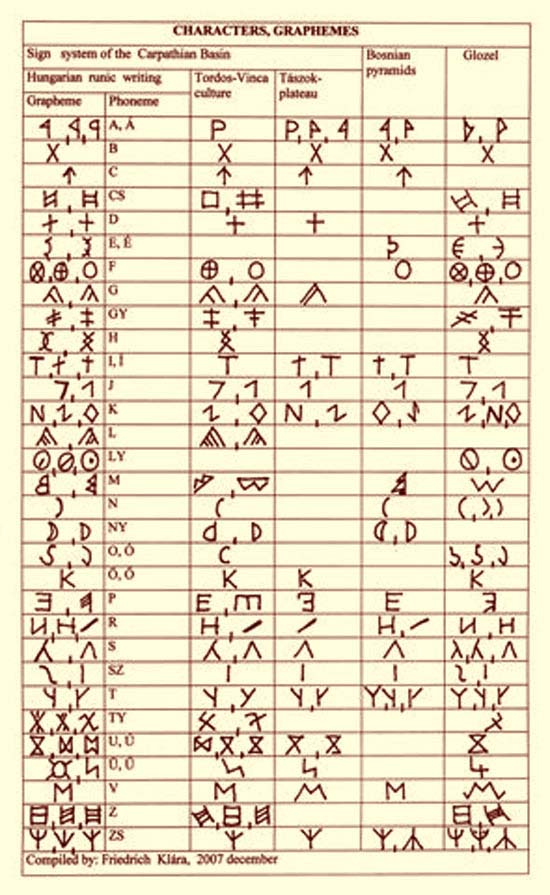
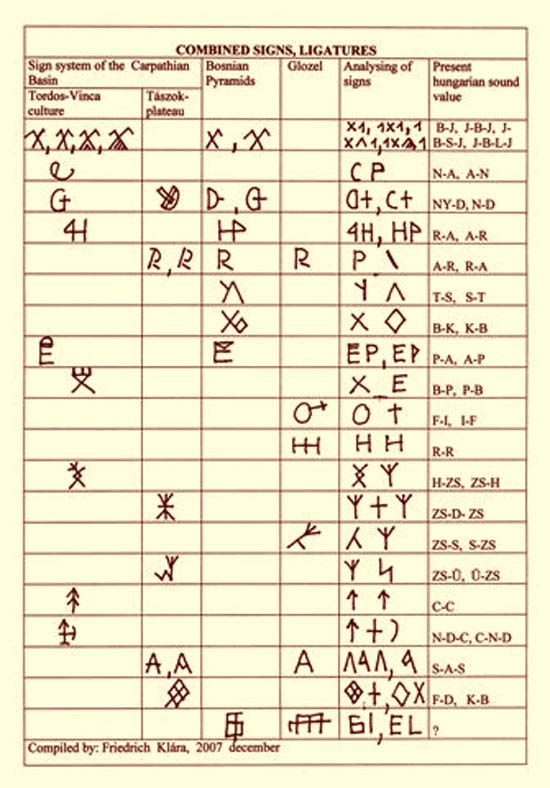
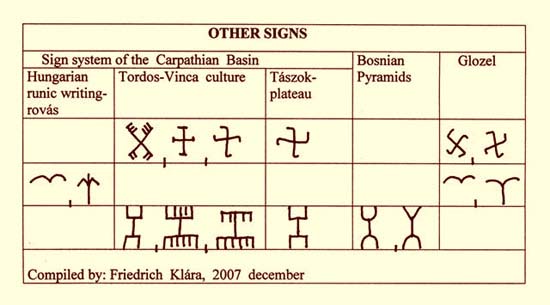
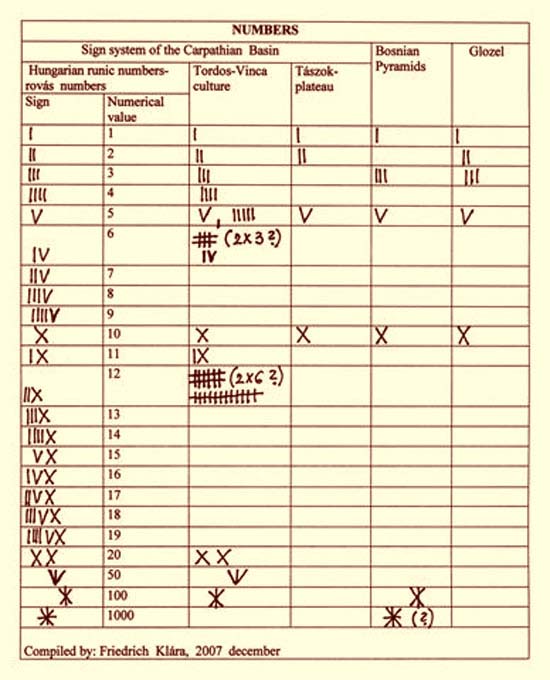
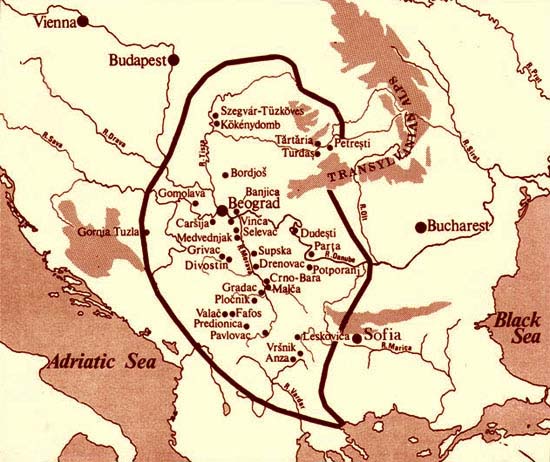
Having reviewed the tables we are entitled to presume that in the Carpathian Basin, on the territory of the Bosnian pyramids and in Glozel representatives of the same culture were acting and left their written signs to us. A remarkable aspect is that on the territory of the historical Hungary (before 1920) these signs are in use even nowadays.
Literatur:
Gimbutas, Marija:
The gods and goddessess of old Europe (Berkeley,1974)
Szakács Gábor: Tudósítások a bosnyák piramisokról (Magyar Demokrata,
2006/26, 45, 48)
Tomory Zsuzsa: Kezdeteink (Miskolci Bölcsész Egyesület, 1995)
Torma Zsófia: Sumer nyomok Erdélyben (Buenos Aires, 1972)
Winn, Shan, M.M: Pre writing in south-eastern Europe (Western Publishers,
1981)
Budapest, in December 2007
Klára Friedrich
Researcher and Teacher of Hungarian Runic (rovás) Writing
|
|
|
Comparison
between the sign-systems...
|
|
|